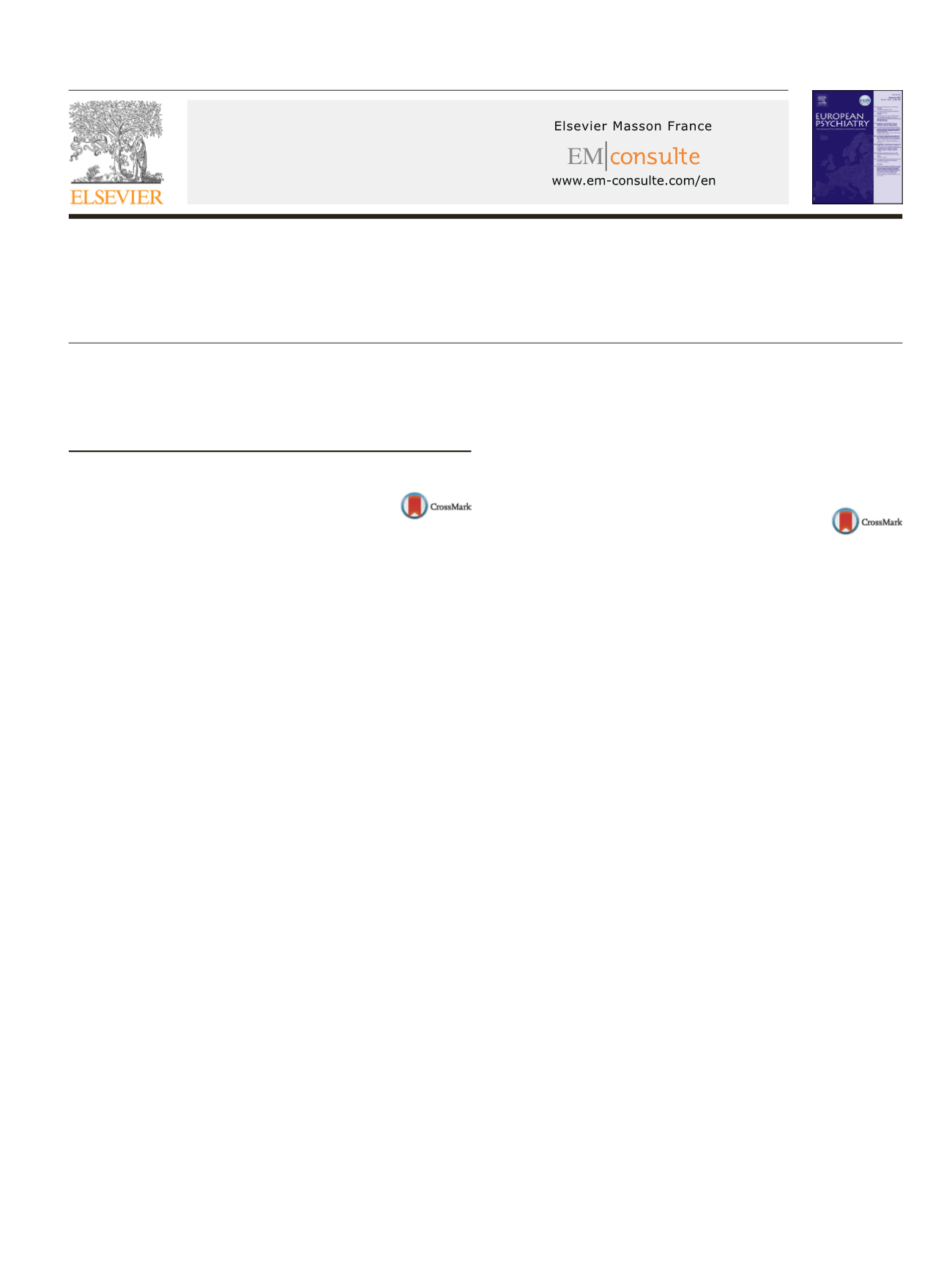
 European Psychiatry 41S (2017) S3–S5
European Psychiatry 41S (2017) S3–S5
Available online at
ScienceDirect
www.sciencedirect.com25th European Congress of Psychiatry
Joint Symposia
Joint symposium: How long do we have to wait for
the antidepressant effect?
JS001
Joint symposium: How long do we
have to wait for the antidepressant
effect? Mechanisms of action for delay
of onset response to antidepressants
F. Artigas
Institut d’investigacions biomèdiques de Barcelona, Spain
Major depressive disorder (MDD) is a severe psychiatric syndrome
with very high prevalence and socioeconomic impact. Monoamine-
based antidepressant drugs (AD) display slow onset of action and
limited efficacy. Preclinical studies show that ADs trigger a series
of slow adaptive mechanisms that limit the clinical response.
These mechanisms result from the pharmacological blockade of
monoamine transporters (SERT, NET) and involve presynaptic,
such as autoreceptor desensitization (e.g., 5-HT
1A
and 5-HT
1B
for
serotonin neurons) as well as postsynaptic mechanisms, such as
increased neurogenesis and expression of trophic factors, increased
dendritic complexity, etc.
Given the strong homeostasis of serotonin and noradrenaline
neurons, a way to improve antidepressant action is to prevent
self-inhibitory presynaptic mechanisms mediated by auto- and
heteroreceptors after reuptake blockade. This strategy was used
in the past with the non-selective 5-HT
1A
antagonist pindolol and
has been incorporated by two recently developed AD (vilazodone
and vortioxetine). Likewise, new molecular strategies using RNA
interference (RNAi) show that the modulation of gene expression
in serotonin neurons offers a great potential. Hence, local or intr-
nasal administration of small interfering RNA (siRNA) molecules
targeting SERT or 5-HT
1A
autoreceptors evokes rapid and robust
antidepressant-like effects in rodents.
Moreover, glutamatergic drugs such as the non-competitive
NMDA receptor antagonist ketmaine, offer a potential for the
development of fast-acting AD due to its rapid and persistent
antidepressant effects in treatment-resistant unipolar and bipo-
lar patients after single i.v. infusion, an effect that likely involves
the activation of AMPA receptors in ventral areas of the cin-
gulate gyrus and the subsequent fast activation of serotonergic
function.
Disclosure of interest
F.A. has received consulting honoraria
on antidepressant drugs from Lundbeck and he has been PI
of grants from Lundbeck. He is also co-author of the patent
WO/2011/131693 for the siRNA and ASO (antisense oligonu-
cleotides) molecules.
http://dx.doi.org/10.1016/j.eurpsy.2017.01.017JS002
What do clinical trials tell us about
antidepressant delayed onset of
action?
J. Rabinowitz
Bar Ilan University, Israel
Response to antidepressants in major depressive disorder is highly
variable and determinants are not well understood. Presentation
will provide clinical trial data on time to response and deter-
minants of response to antidepressant treatment. Data is from
the Innovative Medicines Initiative funded NEWMEDS collabo-
ration, a large public-private collaboration which assembled the
largest dataset of individual patient level information from ran-
domized placebo-controlled trials of antidepressant drugs. Studies
were conducted by four large pharmaceutical companies. Dataset
includes placebo-controlled trials of citalopram, duloxetine, esc-
italopram, quetiapine and sertraline in adults with MDD. We
examined patient and trial-design-related determinants of out-
come as measured by change on Hamilton Depression Scale
or Montgomery–Asberg Depression Rating Scale in 34 placebo-
controlled trials (drug,
n
= 8260; placebo,
n
= 3957). While it is
conventional for trials to be 6–8 weeks long, data presented will
show that drug-placebo differences were observable at week 4
with nearly the same sensitivity and lower dropout rates. Having
any of these attributes was significantly associated with greater
drug vs. placebo differences on symptom improvement: female,
patients being middle aged, increasing proportion of patients on
placebo, excluding all patients from centers with high placebo
response regardless of active treatment response, using active run
in periods and including self-report measures. Proof of concept tri-
als can be shorter and efficiency improved by selecting enriched
populations based on clinical and demographic variables, ensur-
ing adequate balance of placebo patients, and carefully selecting
and monitoring centers. In addition to improving drug discovery,
patient exposure to placebo and experimental treatments can be
reduced.
Disclosure of interest
I have received research grant(s) support
and/or travel support and/or speaker fees and/or consultant fees
from Takeda, Minerva, Intra-cellular Therapies, Janssen (J&J), Eli
http://dx.doi.org/0924-9338/


















